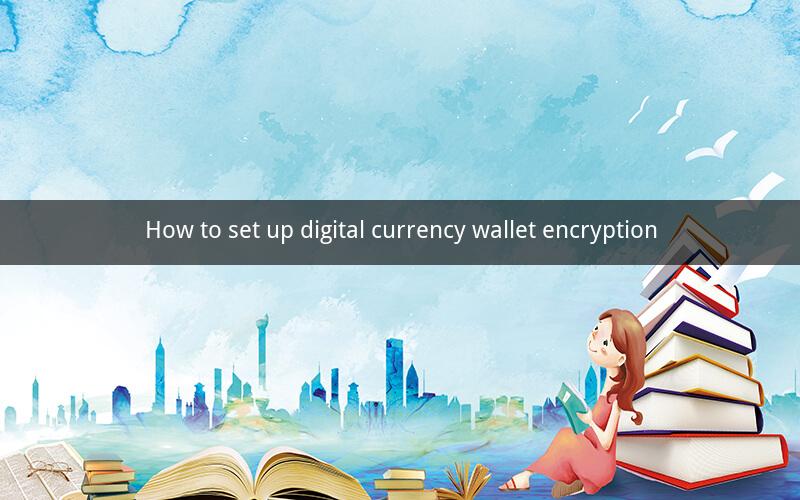
Digital Currency Wallet Encryption: A Comprehensive Guide
Table of Contents
1. Introduction to Digital Currency Wallet Encryption
2. Understanding the Importance of Encryption
3. Types of Digital Currency Wallets
4. Choosing the Right Encryption Method
5. Setting Up Encryption for Mobile Wallets
6. Encrypting Desktop and Web Wallets
7. Best Practices for Managing Encryption Keys
8. Common Encryption Challenges and Solutions
9. Ensuring Security with Multi-Factor Authentication
10. Regularly Updating and Maintaining Wallet Encryption
1. Introduction to Digital Currency Wallet Encryption
In the rapidly evolving world of digital currencies, the security of your assets is paramount. One of the most crucial aspects of maintaining this security is through the use of encryption in your digital currency wallets. This guide will explore the importance of encryption, the different types of wallets, encryption methods, and best practices for setting up and managing wallet encryption.
2. Understanding the Importance of Encryption
Encryption is the process of converting data into a code to prevent unauthorized access. In the context of digital currency wallets, encryption ensures that your private keys—critical for accessing and controlling your assets—are kept secure. Without encryption, your digital currency could be vulnerable to theft or loss.
3. Types of Digital Currency Wallets
There are several types of digital currency wallets, each with its own encryption capabilities:
- Mobile Wallets: These are apps on your smartphone that allow you to store and manage your digital currencies.
- Desktop Wallets: Software installed on your computer that provides a secure storage solution for your digital assets.
- Web Wallets: Online services that allow you to access and manage your digital currencies through a web browser.
4. Choosing the Right Encryption Method
When setting up a digital currency wallet, it's essential to choose the right encryption method. Common encryption methods include:
- AES (Advanced Encryption Standard): Widely used for securing sensitive data, AES is a strong encryption standard.
- RSA (Rivest-Shamir-Adleman): A public-key encryption algorithm that is often used in conjunction with other encryption methods.
5. Setting Up Encryption for Mobile Wallets
To set up encryption on a mobile wallet:
1. Download and install the wallet app from a reputable source.
2. Open the app and create a new wallet.
3. Follow the instructions to set a strong password or PIN.
4. Enable encryption features within the app settings.
5. Back up your wallet to a secure location.
6. Encrypting Desktop and Web Wallets
For desktop and web wallets:
1. Install the wallet software or access the web wallet.
2. Create a strong password or use a passphrase.
3. Enable encryption within the wallet settings.
4. Regularly update the wallet software to ensure security.
7. Best Practices for Managing Encryption Keys
Managing encryption keys is crucial for maintaining wallet security:
- Use Strong, Unique Passwords: Avoid using easily guessable passwords and phrases.
- Backup Your Keys: Store backups of your private keys in multiple secure locations.
- Keep Your Keys Private: Never share your private keys with anyone.
8. Common Encryption Challenges and Solutions
Some common challenges with encryption include:
- Complexity: Encryption can be complex to set up and manage. Use wallet guides and tutorials to help you through the process.
- Performance: Encryption can slow down wallet operations. Choose a wallet that balances security and performance.
9. Ensuring Security with Multi-Factor Authentication
To enhance security, consider using multi-factor authentication (MFA) in addition to encryption:
- Enable MFA: Most wallets offer MFA options such as SMS verification, email verification, or hardware tokens.
- Use MFA for All Transactions: Always require MFA for sending or receiving digital currencies.
10. Regularly Updating and Maintaining Wallet Encryption
Regular maintenance is key to keeping your wallet secure:
- Update Wallet Software: Regularly update your wallet software to patch security vulnerabilities.
- Monitor Security News: Stay informed about the latest security threats and best practices.
FAQs
1. What is the difference between encryption and hashing?
- Encryption is the process of converting data into a code, while hashing is a one-way process that creates a unique code for data.
2. Can I use the same password for my wallet and other accounts?
- No, it's crucial to use unique passwords for each account to prevent unauthorized access.
3. How do I recover my digital currency if I lose my private keys?
- If you have backups of your private keys, you can recover your digital currency. Otherwise, you may lose access to your funds.
4. Is it safe to use a web wallet?
- Web wallets can be safe if they are reputable and well-maintained. Always use two-factor authentication and keep your software updated.
5. What should I do if I think my wallet has been compromised?
- Change your password immediately, enable two-factor authentication, and monitor your account for suspicious activity.
6. Can I encrypt my wallet without a password?
- While it's possible to encrypt your wallet without a password, it's not recommended as it could lead to accidental loss of access to your funds.
7. How long does it take to encrypt a wallet?
- The time it takes to encrypt a wallet varies depending on the size of the wallet and the speed of your device.
8. Is there a limit to the number of encryption keys I can have?
- There is typically no limit to the number of encryption keys you can have, but it's important to manage them securely.
9. Can I encrypt my wallet on a public computer?
- It's not recommended to encrypt your wallet on a public computer as it may not be secure.
10. What is the best way to keep my encryption keys safe?
- Store your encryption keys in a secure, offline location. Consider using hardware wallets or secure vaults for additional protection.